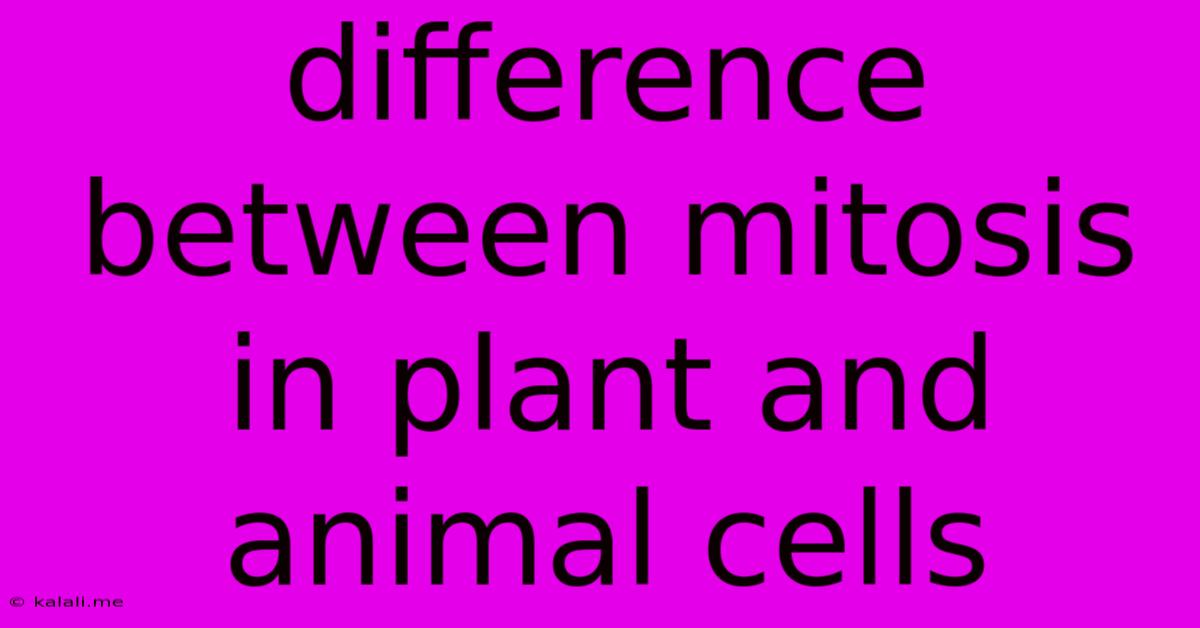Difference Between Mitosis In Plant And Animal Cells
Kalali
Jun 13, 2025 · 3 min read

Table of Contents
The Great Divide: Unveiling the Differences Between Plant and Animal Cell Mitosis
Mitosis, the process of cell division resulting in two identical daughter cells, is fundamental to life. While the overall goal remains the same in both plant and animal cells, subtle yet crucial differences exist in how this intricate process unfolds. This article delves into the key distinctions between plant and animal cell mitosis, highlighting the unique challenges and adaptations each cell type exhibits. Understanding these differences is vital for grasping the complexities of cellular biology and the diverse strategies employed by life across kingdoms.
Key Differences: A Comparative Overview
Both plant and animal cells undergo mitosis to produce genetically identical daughter cells. However, the structural differences between these cell types necessitate variations in the mitotic process. These variations are primarily observed during cytokinesis, the final stage of cell division where the cytoplasm divides, creating two separate cells. Other subtle differences also exist in the prophase and metaphase stages, relating to the presence or absence of certain structures.
1. Cytokinesis: The Defining Difference
-
Animal Cells: Animal cell cytokinesis involves the formation of a cleavage furrow. This furrow, a contractile ring of actin filaments, gradually pinches the cell membrane inward, eventually separating the cytoplasm and forming two independent daughter cells. Think of it like tightening a drawstring bag until it splits into two.
-
Plant Cells: Plant cells, encased by a rigid cell wall, cannot undergo cleavage furrow formation. Instead, cytokinesis involves the construction of a cell plate. Vesicles carrying cell wall materials converge at the center of the cell, fusing together to form the cell plate. This cell plate gradually expands outwards, eventually reaching and fusing with the parental cell wall, thus creating two daughter cells separated by a new cell wall. This process is significantly more complex and requires the coordinated delivery of various cellular components.
2. Preprophase Band and Phragmoplast: Unique Plant Cell Structures
Plant cell mitosis showcases unique structures absent in animal cells:
-
Preprophase band: A ring of microtubules that forms just before the onset of mitosis in plant cells. This band marks the future plane of cell division and plays a crucial role in guiding the positioning of the cell plate during cytokinesis.
-
Phragmoplast: A structure composed of microtubules and other components that forms between the two daughter nuclei during late anaphase and telophase. The phragmoplast guides the movement of vesicles that will contribute to cell plate formation, ensuring its proper positioning and expansion.
3. The Role of Centrosomes: A Subtle Distinction
While both cell types utilize microtubules in spindle fiber formation during mitosis, the origin of these microtubules varies slightly.
-
Animal Cells: Animal cells typically have a pair of centrosomes, each containing two centrioles, which act as microtubule organizing centers (MTOCs). These centrosomes migrate to opposite poles of the cell during prophase, forming the spindle poles and guiding the assembly of the spindle microtubules.
-
Plant Cells: Plant cells usually lack well-defined centrosomes. While they do have microtubule organizing centers, their structure and function differ slightly from animal centrosomes. The spindle microtubules originate from other locations within the cell, such as the nuclear envelope.
4. Cell Wall: A Structural Constraint
The presence of a rigid cell wall in plant cells significantly influences the process of cytokinesis, as previously discussed. This constraint necessitates the unique cell plate formation mechanism, a process absent in animal cells. The cell wall's rigidity also impacts the overall shape and mechanics of cell division in plant cells.
Conclusion: A Tale of Two Divisions
Mitosis, although a fundamental process shared by all eukaryotic cells, showcases fascinating variations depending on the cell type. The differences between plant and animal cell mitosis, primarily concentrated in cytokinesis and the presence of specialized structures like the preprophase band and phragmoplast, highlight the remarkable adaptability of cellular processes to diverse biological environments and structural constraints. These variations are a testament to the evolutionary ingenuity behind the seamless perpetuation of life.
Latest Posts
Latest Posts
-
How Many Grams Is In A Half Ounce
Jul 01, 2025
-
What Is 20 Of A Million Dollars
Jul 01, 2025
-
Harrison Garage Door Opener Hd 9700 User Manual
Jul 01, 2025
-
How Long Can Sour Cream Be Left Out
Jul 01, 2025
-
How Old Am I If I Was Born In 1986
Jul 01, 2025
Related Post
Thank you for visiting our website which covers about Difference Between Mitosis In Plant And Animal Cells . We hope the information provided has been useful to you. Feel free to contact us if you have any questions or need further assistance. See you next time and don't miss to bookmark.